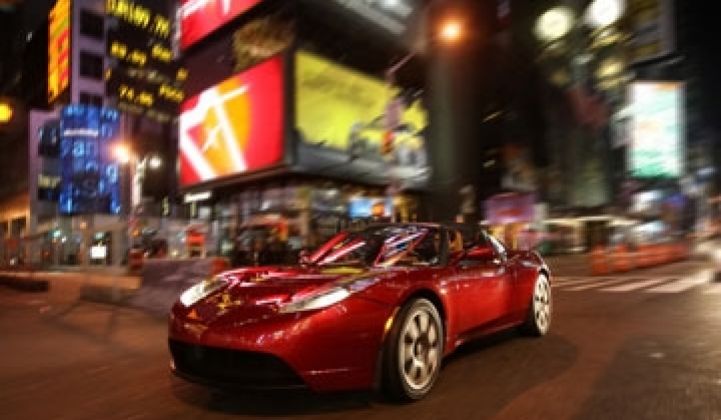Maybe they should start thinking about free hot dogs and balloons for the kids.
Tesla Motors, which is expected to launch a much-ballyhooed initial public offering next week, seems to have lost some of its momentum among high-end car buyers.
In the first quarter of the year, Tesla sold a total of 126 cars, according to a four-digit subtraction equation (with borrowing) undertaken by editors at Greentech Media. At the end of 2009, the company had cumulatively sold 937 cars, according to the initial S-1 filing (the prelude to an initial public offering), which was filed in March. In the amended S-1 filed June 15, the company said it had sold a total of 1,063 production cars to customers since the start of the company through March 31, 2010.
1,063 minus 937 comes to 126 cars sold in the first quarter of 2010. With thirteen weeks in the first quarter, that comes to 9.7 cars sold a week.
Back in December 2008, when Tesla was just beginning to move toward volume production, CEO Elon Musk said that Tesla was producing 15 cars a week and wanted to ramp up to 30 cars a week by the spring of 2009. Tesla reiterated the estimates in March 2009 to Car and Driver.
The 30-a-week goal proved elusive. Tesla sold an average of 16 to 17 cars a week in 2009 (837 cars shipped divided by 52 or 50 weeks; approximately 100 left the factory in 2008).
The economy has remained in a slump, but the economy was actually worse back in December 2008 and early 2009 than it is today. Either way, the company is selling fewer cars than it did during the initial ramp and less than expectations would dictate. (Sales and shipments at the moment are largely synonymous for the company, as Tesla does not have to complete final assembly until the buyer has paid.)
A few qualifications: First, the company currently only sells the Tesla Roadster, which retails for $109,000. Only so many buyers for cars like that exist in the world. The company also continues to have a long waiting list. An estimated 3,940 customers have put $5,000 deposits down on the Model S, the all-electric sedan coming in 2012. (UPDATE: Darryl Siry points out that page 35 of the S-1 says 2,200 Model S deposits have been taken: apparently some have paid higher than $5,000.) The S-1 states:
"As of March 31, 2010, we had collected reservation payments for undelivered Tesla Roadsters in an aggregate amount of $6.3 million and reservation payments for Model S sedans in an aggregate amount of $19.7 million."
Thus, demand is there. It just isn't as substantial as once projected. And in all fairness, the 1,063 cars sold is 1,063 more cars than the number of units competitor Fisker Automotive has sold. Fisker's Karma was originally due in late 2009. Now it is slated to come out later this year. (Tesla can also be credited with bringing the concept of electric cars back from the grave.)
Tesla plans to sell 11.1 million shares of stock for $16 a share, according to the latest S-1 filed with the SEC. If successful, the IPO could raise over $200 million for the company and ignite a post-IPO trading frenzy.
Investors seem to like green, at least temporarily. Before its IPO in the fall of 2009, battery maker A123 Systems raised its offering price from the $8 to $13. The stock shot up to $20 after the IPO in September 2009 despite serial losses, some skepticism, and the loss of the GM-Volt contract. Losses continued and the company began to lose business from customers like Black & Decker. Now, A123 stock wallows at around the $9 level.



